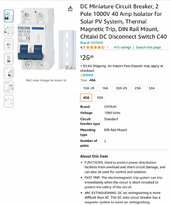RV8R
Solar Enthusiast
For my remote cabin, I am considering a “Combiner Box” or a “Breaker” for the “Primary” function as a PV Array “Disconnect”.
Currently I have 6 100W panels 3S2P so roughly 600W ( 60 volts @ 10 amps ). I have a Victron 100 | 50 MPPT
I consider the combiner box a choice for future upgrades, but think I would go with just a breaker for now.
So if you recommend a breaker similar to this;

I am seeking product recommendations.
I am assuming one advantage of going this route would be to satisfy Victron’s fine wire seated into their screw terminals ( PV side ). For clarity, I am assuming a breaker like this will take PV solar wire on the PV side & fine wire on the MPPT side, so a disconnect switch & wire connection swap point ,,, If you have knowledge in this area I am all ears / eyes.

I tend to get lost in internet rabbit holes when shopping for such items.
TIA
Currently I have 6 100W panels 3S2P so roughly 600W ( 60 volts @ 10 amps ). I have a Victron 100 | 50 MPPT
I consider the combiner box a choice for future upgrades, but think I would go with just a breaker for now.
So if you recommend a breaker similar to this;

I am seeking product recommendations.
I am assuming one advantage of going this route would be to satisfy Victron’s fine wire seated into their screw terminals ( PV side ). For clarity, I am assuming a breaker like this will take PV solar wire on the PV side & fine wire on the MPPT side, so a disconnect switch & wire connection swap point ,,, If you have knowledge in this area I am all ears / eyes.

I tend to get lost in internet rabbit holes when shopping for such items.
TIA
Last edited:



